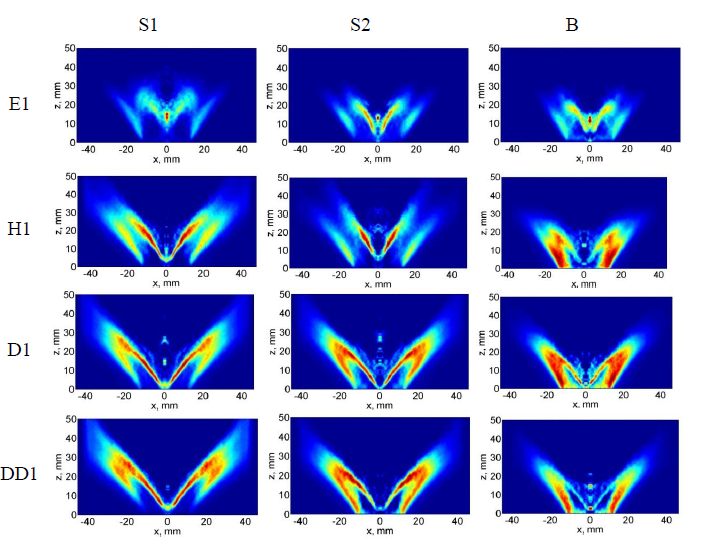The Swirl Flames Data Repository
Introduction
Welcome to The Swirl Flames Data Repository developed over the years by Cavaliere, Kariuki, Mastorakos, Sidey, Yuan and co-workers in the University of Cambridge Department of Engineering. The data in this website have been collected from a series of experiments on a swirl bluff-body burner at the University of Cambridge. The primary focus of research on this burner has been to understand the mechanisms of local and global extinction in swirl stabilised flames. Because of this, these flames show, by design, significant finite-rate kinetic effects. The dataset presented in this repository is continually being supplemented. Future datasets will include emissions measurements.
Although the primary geometry discussed on this website has remained identical, a range of flames with varying fuel injection strategies have been investigated. For the purposes of the Turbulent Combustion of Sprays Workshop, spray flames are the current topic of interest. This repository currently contains imaging and Phase Doppler Anemometry (PDA) data collected from flames of various liquid fuels.
The Cambridge Swirl Bluff-body burner has also been used to study fully premixed, non-premixed with axial fuel injection, non-premixed with radial fuel injection, and dual-fuel flames. In providing this data through means of this repository, we hope that a CFD modeller may study a wide range of flame conditions and combustion phenomena by investing in a single geometry.

Photographs of stable spray flames of (from left to right) ethanol at E1S1, n-heptane at H1S1, n-decane at D1S1, and n-dodecane at DD1S1. [Yuan PhD]
Data available
All the flames presented here have similar velocity fields, as they have identical swirl numbers and burner geometry, and similar bulk air velocities, Ubulk. However, at present, detailed velocity measurements are available only for some flames.
The available data cover the following configurations and conditions.
1. Cold flow measurements
These experiments are single-component LDA measurements of the air-only flow (no fuel), at a bulk velocity close to the velocities used in the combustion experiments. These data are included in [Tyliszczak 2014].
We recommend that the modeller of any of the present flames first attempts to reproduce the cold flow data so that grid independence and the underlying CFD is assessed.
2. Spray flame measurements
These spray flames form part of the Turbulent Combustion of Sprays Workshop.
2.1 Single-component fuels
This repository contains data from ethanol, n-heptane, n-decane, and n-dodecane flames. The fuel and condition characteristics are given here. The data include: blow-off curves; PDA; 5 kHz OH* chemiluminesence; and 5 kHz OH-PLIF. For n-heptane flames, 10 Hz simultaneous OH/CH2O-PLIF is available upon request. The publications corresponding to these datasets are [Yuan PhD], [Yuan 2015].
The ethanol flame has been modelled at the University of Cambridge using LES/CMC [Giusti 2017].

Inverse Abel transformed mean OH* chemiluminescence of stable flames at far from (column 1: S1) and close to blow-off (column 2: S2), and unstable flames at blow-off condition (column 3: B) from the four fuels: row 1: Ethanol (E1), row 2: n-Heptane (H1), row 3: n-Decane (D1) and row 4: n-Dodecane (DD1). [Yuan PhD]
2.2 Multi-component fuels - Coming Soon
Flames with kerosene fuel from the National Jet Fuel Combustion Program will be added shortly. The available data will include: blow-off conditions; 5 kHz OH* Chemiluminescence; 5 kHz OH-PLIF; Mie Scattering; and Fuel-PLIF. These data are described in [Allison 2017] and [Sidey 2017].
3. Premixed flame measurements, methane
The swirl methane premixed flames have been described in [Kariuki PhD] and by [Cavaliere 2013]. The data includes: blow-off conditions; OH* Chemiluminescence; OH-PLIF; and blow-off dynamics. Download.
4. Non-premixed axial- and radial-injection flame measurements, methane
The swirl, axial-injection and radial-injection flames with methane have been studied in terms of local extinction, global extinction and blow-off dynamics [Cavaliere 2013]. Some datasets relating to these flames are now available. Download non-premixed axial flame measurements by Cavaliere 2013. The data includes: blow-off conditions; LDA; 5 kHz OH* Chemiluminescence; 5 kHz OH-PLIF; and blow-off dynamics. Data for radial-injection and more data for axial-injection will be available soon.
This flame has also been modelled at the University of Cambridge using LES/CMC [Zhang 2015].
5. Dual-fuel mixed-mode flame measurements, ethanol-methane - Coming Soon
In an effort to provide a configuration very challenging for turbulent combustion models and a canonical stationary combustion system of relevance to dual-fuel (pilot-ignited) gas engines, the ethanol spray flame described above above has also been studied with increasingly amounts of methane in the air inlet. This has resulted in a dual-fuel dataset published in [Sidey 2016]. The focus of this study was primarily stabilisation behaviour. Available data will include: 5 kHz OH* Chemiluminescence and 5 kHz OH-PLIF.

